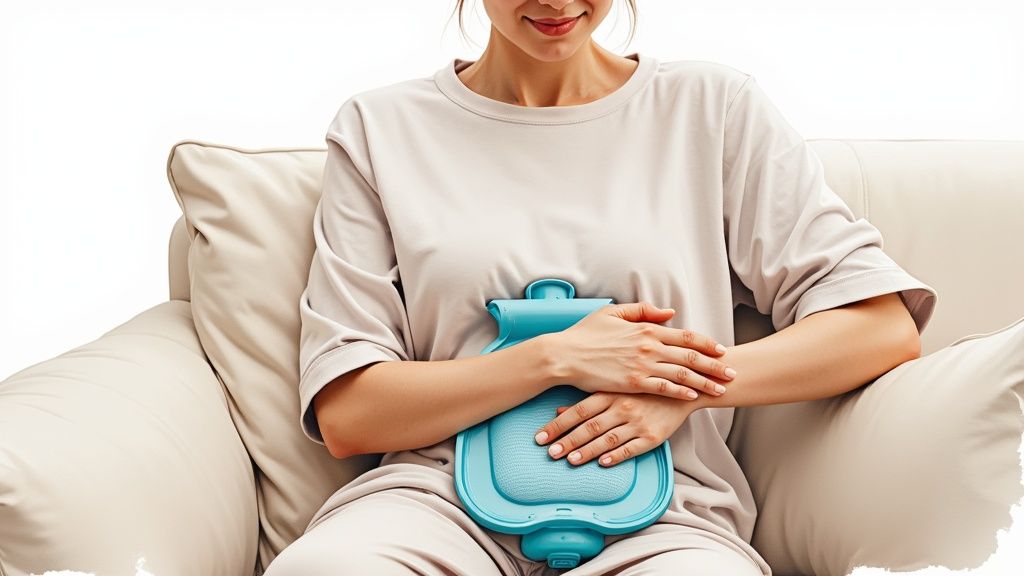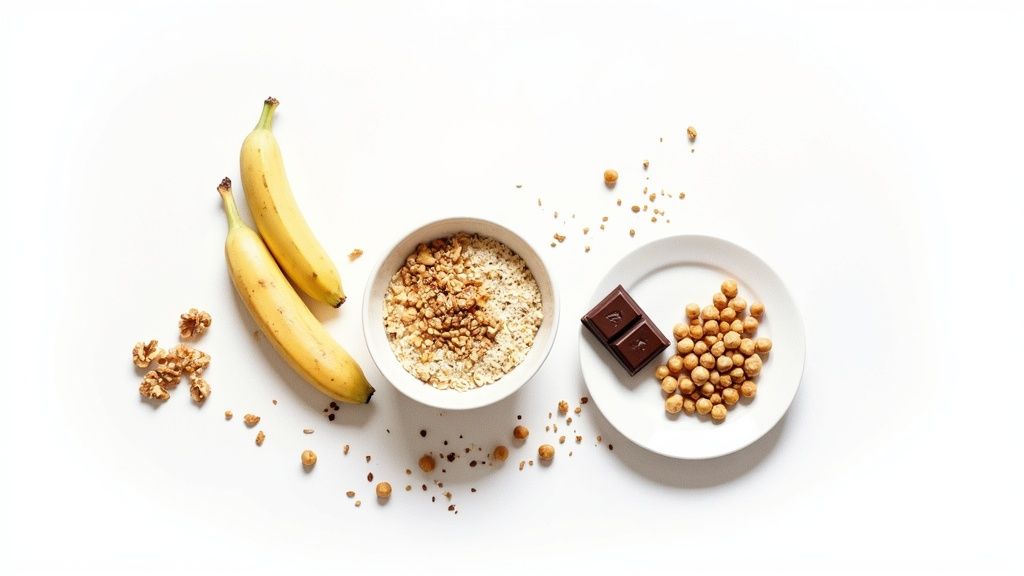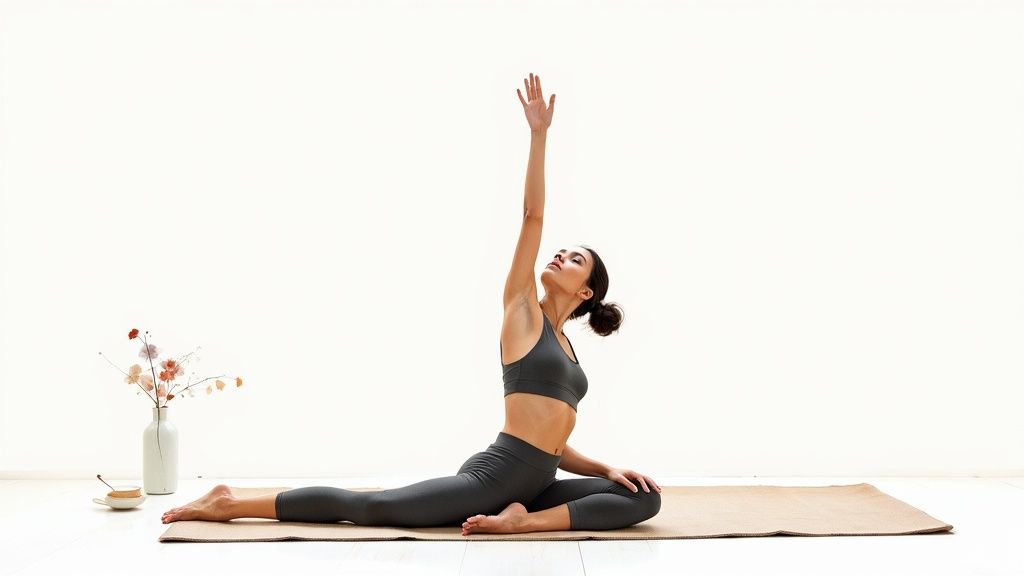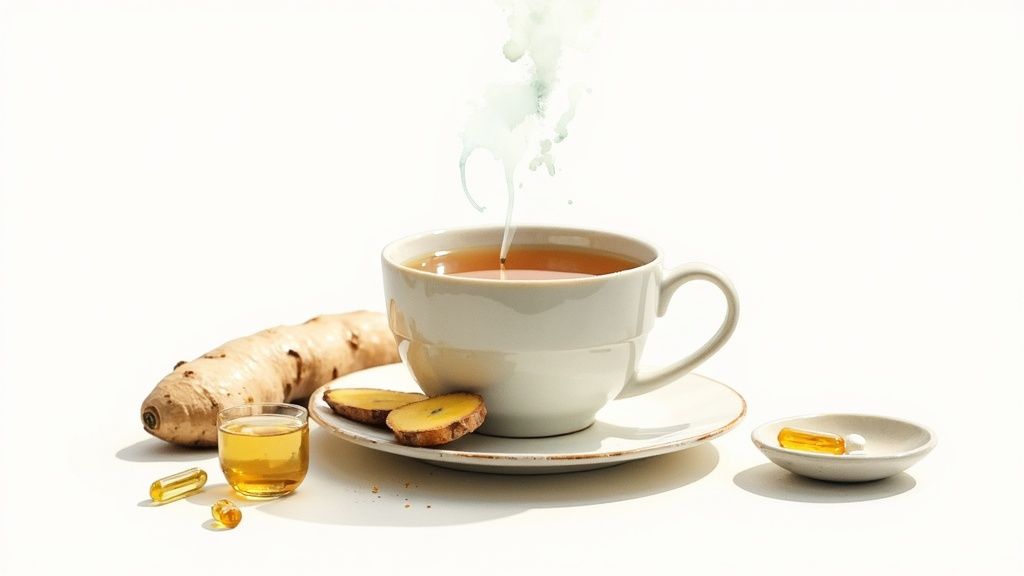How to Relieve Period Cramps Naturally: Fast Relief
-
When period cramps hit, your first thought is probably how to get rid of them—fast. The best natural approaches focus on a few key things: relaxing your uterine muscles, taming inflammation, and calming your nervous system right down. Simple, time-tested methods like curling up with a heating pad, a gentle belly massage, or even some light movement can work wonders by boosting blood flow and encouraging your body to release its own natural painkillers.
Your Quick Guide to Easing Period Pain Naturally
When you're dealing with that all-too-familiar ache, you want relief that’s effective but doesn’t come with a long list of side effects. The great news is you likely have powerful, natural solutions right at your fingertips. These methods aren't magic; they tap into your body’s built-in healing systems. They work by easing the intense uterine contractions, dialing back the inflammation kicked up by prostaglandins, and boosting endorphins—your body’s own feel-good chemicals.

Many of these natural methods, especially specific breathing exercises, are all about working with your body to manage discomfort. Understanding the healing power of breathwork can give you an incredible tool for controlling pain from the inside out.
The Best Natural Remedies at a Glance
Instead of playing a guessing game when you're in pain, here's a quick cheat sheet. This table breaks down some of the most effective, science-backed natural remedies for period cramps, explaining why they work and how quickly you can expect to feel better. It’s your go-to reference before we dive deeper into each one.
Top 5 Natural Remedies for Fast Period Cramp Relief
| Remedy | How It Helps | Speed of Relief | Pro Tip |
|---|---|---|---|
| Heat Therapy | Relaxes uterine muscles and boosts blood flow to the abdomen, easing contractions. The warmth provides immediate comfort. | Within 10-15 minutes | Use a microwavable heat pack for consistent, deep-penetrating warmth that molds to your body. |
| Gentle Massage | Eases muscle tension and spasms in the lower abdomen. Can also help reduce bloating and discomfort. | Within 5-10 minutes | Use a few drops of lavender or clary sage essential oil with a carrier oil for added calming effects. |
| Light Exercise | Releases endorphins (natural painkillers) and improves circulation to reduce pelvic pain. | Within 20-30 minutes | Try restorative yoga poses like Child's Pose or go for a brisk walk to get your blood flowing. |
| Herbal Teas | Certain herbs like ginger and chamomile have anti-inflammatory and anti-spasmodic properties to reduce pain. | Within 30-60 minutes | Brew fresh ginger tea with a slice of lemon for a potent anti-inflammatory drink. |
| Magnesium Intake | Helps regulate muscle contractions and nerve function, which can reduce the severity of cramps. | Long-term (best results after consistent use) | Add magnesium-rich foods like dark chocolate, avocados, and nuts to your diet daily. |
Think of this table as your starting point for finding what works best for your body. Now, let's explore how to put these remedies into action.
Using Heat and Touch for Soothing Relief
When period cramps hit, sometimes the simplest, most classic remedies are the ones that work best. A little warmth and gentle pressure can be incredibly effective, offering fast relief right when you need it. There's a reason these methods have been passed down for generations—they work directly on the source of the pain, helping to relax those tense uterine muscles and boost blood flow.
Think about it: cramps are just intense muscle contractions. Applying heat helps those muscles unclench. Imagine your muscles are a tightly clenched fist; heat coaxes that fist to open up and relax. The warmth encourages blood to circulate more freely, which in turn helps flush out the chemical messengers, called prostaglandins, that are responsible for the pain. This is the incredible benefit of heat therapy: it provides deep, penetrating relief that feels like a warm hug for your aching abdomen.

And this isn't just folk wisdom. A major review of self-care techniques published by the National Library of Medicine found that heat application has a significant, moderate effect on reducing menstrual pain. It’s a reliable tool to have in your corner when the cramps kick in.
Putting Heat Therapy to Work
You don’t need any special training to use heat therapy effectively—just a good source of warmth and a little time to let it work its magic. The idea is to apply a comfortable, steady temperature to your lower abdomen or back.
Here are a couple of my go-to options:
- At Home: You can't beat a classic hot water bottle or a microwavable heat pack when you're curled up on the couch. I especially like the modern packs filled with flax seeds or rice because they mold to your body and add a bit of gentle, weighted pressure.
- On the Go: Let's be real, life doesn't stop for your period. For days when you have to be at work or out running errands, those discreet stick-on heat patches are a total game-changer. They fit right under your clothes and deliver hours of low-level heat, so you can get through your day without being doubled over in pain.
Picture this: you’re in the middle of a long meeting, and you feel that familiar, dreaded ache start to build. A discreet heat patch can make the difference between powering through and having to tap out. If you're curious about the science behind it, we have a great guide on understanding the basics of heat therapy.
The Power of Gentle Massage
Want to boost the effects of your heat pack? Try adding a gentle self-massage into the mix. This combination is a true powerhouse for cramp relief. The benefit of massage therapy is that it physically encourages your abdominal muscles to release their tension, while also helping to calm your nervous system and dial down your perception of pain. I find it’s especially helpful right before bed to help you get a more restful night's sleep.
You don’t have to be a massage therapist. A simple, five-minute ritual can make a world of difference.
A Simple Self-Massage Ritual:
- Warm up your hands by rubbing your palms together briskly.
- Add a few drops of a calming oil, like lavender or clary sage, mixed into a carrier oil like coconut or almond.
- Lie down somewhere comfortable and place your warm, oiled hands on your lower abdomen.
- Using your fingertips, begin massaging in a slow, clockwise circular motion. Start with big circles around your belly button and gradually make them smaller, concentrating on the area below your navel.
- Breathe slowly and deeply as you go. This helps relax your entire body and amplifies the effects of the massage.
This small act of self-care does more than just address the physical pain. It’s a way to connect with your body and give it some gentle attention during what can be a really challenging time of the month.
Eating to Beat Monthly Pain
The food on your plate has a powerful, direct influence on how you feel during your period. I’ve learned over the years that what you eat can either calm the inflammation and soothe those relentless muscle contractions or, unfortunately, make them a whole lot worse. This isn't about some strict, punishing diet, but about making small, strategic shifts that build your body's resilience against pain over time.
Instead of overhauling your entire kitchen, think in terms of simple, smart swaps. Trading a bag of chips for a handful of walnuts or swapping a sugary afternoon treat for a square of dark chocolate are easy wins. It's a small change, but both walnuts and dark chocolate are packed with muscle-relaxing magnesium and anti-inflammatory compounds that really do work in your favor.

This proactive approach is all about giving your body the nutrients it needs before the cramps even have a chance to take hold. By focusing on whole, unprocessed foods, you're not just managing pain—you're nurturing your overall hormonal health.
Foods That Fight Inflammation and Cramps
To really get how diet can relieve period cramps naturally, it helps to focus on nutrients that actively fight the sources of the pain: inflammation and muscle spasms. The key players here are omega-3 fatty acids, magnesium, and certain B vitamins. They're your nutritional allies.
Here’s what a pain-fighting plate could look like:
- Omega-3 Rich Foods: These healthy fats are inflammation’s worst enemy. You'll find them in fatty fish like salmon, but also in great plant-based options like flaxseeds, chia seeds, and walnuts.
- Magnesium Powerhouses: Think of this mineral as a natural muscle relaxant. It's abundant in leafy greens (spinach, kale), nuts and seeds (almonds, pumpkin seeds), good-quality dark chocolate, and avocados.
- Vitamin B-Rich Choices: Vitamins B1 and B6 are especially helpful for reducing bloating and easing muscle spasms. Load up on bananas, chickpeas, oats, and lentils.
The research backs this up time and again. Studies suggest that simply reducing overall fat intake, especially from animal sources high in inflammatory omega-6s, can lessen menstrual pain. On the flip side, increasing anti-inflammatory omega-3s from fish and nuts has been linked to a real reduction in cramp severity. One Danish study even highlighted the benefits of combining fish oil with vitamin B12. You can read more about these nutritional findings from University of Utah Health.
What to Limit During Your Period
Just as important as what you add to your diet is what you choose to limit. Some foods can actually increase the production of prostaglandins, the compounds that lead to more intense uterine contractions and pain. In the days leading up to and during your period, it’s a good idea to scale back on these items.
Key Takeaway: The main goal is to keep inflammation low. Foods packed with refined sugars, trans fats, and too much salt can trigger an inflammatory response that may amplify your cramps.
Consider cutting back on:
- Processed Foods: Think packaged snacks, fast food, and sugary drinks. They often contain high levels of unhealthy fats and refined carbs that just fuel inflammation.
- Red Meat and Full-Fat Dairy: These can be high in arachidonic acid, an omega-6 fatty acid that your body converts into those inflammatory prostaglandins.
- Caffeine and Alcohol: I know that morning coffee can feel essential, but both caffeine and alcohol can contribute to dehydration and bloating, which sometimes makes cramps feel even worse.
Focusing on an anti-inflammatory diet creates a strong foundation for managing pain. For a deeper dive, explore our guide on reducing inflammation naturally.
How Gentle Movement Reduces Cramps
When you're doubled over with cramps, the idea of exercising is probably the last thing on your mind. It sounds completely counterintuitive, right? But believe it or not, gentle movement is one of the most powerful tools you have for natural period pain relief. It works by tackling the pain from a few different angles, bringing both immediate comfort and lasting benefits.
First, let's talk about endorphins. These are the amazing chemicals your body produces that act as natural painkillers and mood boosters. When you engage in some light physical activity, your brain gets the signal to release them. The result? Your perception of pain actually dulls, and you get a welcome lift in your overall mood.

On top of that, gentle exercise gets your blood flowing. Better circulation throughout your body—including your pelvic region—helps to relax those intense uterine muscle contractions. It can also reduce the pelvic congestion that causes that heavy, achy sensation so many of us know all too well.
Finding Movement That Feels Good
Let's be clear: this isn't about pushing through a grueling HIIT session or a five-mile run. The goal here is to listen to your body and choose movements that feel good and restorative, not punishing. Even a little bit of activity can make a world of difference.
Try weaving one of these simple activities into your day:
- A Brisk Walk: Getting outside for a 20-minute walk can be a game-changer. It boosts circulation and gives you the added mental health benefits of fresh air and sunlight, which is perfect for breaking that cycle of pain and feeling down.
- Gentle Stretching: A few simple stretches can work wonders for releasing tension in your lower back, hips, and abdomen—all the spots that tend to get tight and sore during your period.
- Restorative Yoga: A slow, mindful yoga practice is perfect for easing into movement when you're not feeling 100%. It pairs gentle stretching with deep breathing, which is fantastic for calming your entire nervous system.
Think about it this way: you're working from home and feel the familiar cramps starting to build. Instead of reaching for painkillers right away, what if you stepped away from your desk for just 15 minutes? Roll out a mat and gently move through a few rounds of Cat-Cow. You might be shocked at how quickly that simple movement starts to dissolve the tension in your lower back.
Simple Stretches for Immediate Relief
You don't have to be a yoga pro to get relief. These three simple stretches are easy to do right in your living room and are specifically designed to target the discomfort that comes with cramps.
1. Child’s Pose (Balasana)
This classic resting pose is a lifesaver for gently stretching the lower back and hips. Just kneel on the floor, sit back on your heels, and fold forward until your forehead rests on the mat. You'll feel it releasing pressure and tension in your whole pelvic area.
2. Cat-Cow Pose (Marjaryasana-Bitilasana)
Start on your hands and knees. When you inhale, let your belly drop and look up toward the ceiling (Cow pose). As you exhale, round your spine and tuck your chin to your chest (Cat pose). This fluid movement is great for warming up the spine and gently massaging your abdominal organs, which helps get the blood flowing.
3. Supine Twist
Lie flat on your back and hug your knees into your chest for a moment. Then, extend your arms out to your sides like a "T" and gently let both knees fall to one side, trying to keep your shoulders flat on the floor. This twist is amazing for releasing tightness in the lower back and can feel incredibly soothing for an aching belly.
Turn to Herbal Teas and Supplements for Natural Support
Once you’ve got your diet and movement dialed in, certain herbs and supplements can offer some much-needed backup for period cramps. Think of a warm, comforting cup of tea—it’s not just a cozy ritual. It can actually deliver powerful anti-inflammatory and muscle-relaxing goodness right where you need it most.
In the same way, targeted supplements can help fill in nutritional gaps that might be making your cramps worse than they need to be. These are your allies during your cycle. A heating pad soothes from the outside, but a cup of ginger tea can work its magic from the inside out.

Soothing Teas for Menstrual Relief
Herbal teas are one of the most gentle and effective ways to tackle period pain. They’re simple to make and offer a dose of both physical and emotional comfort when you’re feeling rough.
- Ginger Tea: Ginger is a true powerhouse. Its anti-inflammatory effects are so potent that some studies show it works a lot like ibuprofen, blocking those pain-causing prostaglandins. Just simmer a few slices of fresh ginger root in hot water for 10 minutes for an easy, effective brew.
- Chamomile Tea: This is your go-to for deep relaxation. Chamomile contains compounds that help relax the uterine muscles, which can take the edge off intense spasms. Plus, its calming vibe is great for easing irritability and helping you get some much-needed rest.
- Peppermint Tea: If bloating and an upset stomach are part of your monthly misery, peppermint tea is a lifesaver. The menthol helps soothe your digestive system and relax those tight abdominal muscles. You might also be interested in learning about the soothing powers of lavender for pain relief, another fantastic botanical ally.
Navigating Supplements with Care
Walk down any health aisle, and you’ll see dozens of supplements promising menstrual relief. It’s crucial to approach them with a healthy dose of skepticism and, most importantly, have a chat with your doctor first.
A big Cochrane review that looked at 27 different trials found that while solid, high-quality evidence is still thin for many options, a few did show real promise. The review found some limited evidence that fish oil and fenugreek could lessen pain intensity, and chamomile also showed potential.
Key Takeaway: Always talk to your doctor before starting a new supplement. They can help you figure out the right dose and make sure it won’t interfere with any medications you're taking or other health conditions.
Here are a few supplements that have some good evidence behind them:
- Magnesium: This mineral is a game-changer for muscle relaxation. It helps calm uterine contractions and can significantly reduce the severity of cramps. I’ve found that taking magnesium glycinate daily, especially in the week leading up to my period, makes a huge difference.
- Fish Oil (Omega-3s): Loaded with anti-inflammatory fatty acids, fish oil helps lower the prostaglandin levels that are at the root of so much menstrual pain.
- Vitamin B1 (Thiamine): Some research suggests that taking Vitamin B1 consistently can help cut down on both the intensity and duration of period cramps.
You can dive deeper and discover which essential vitamins for balancing female hormones, like Magnesium and the B Vitamins, are key players in reducing period discomfort.
Your Questions on Natural Cramp Relief, Answered
When you're trying to manage period pain naturally, a lot of practical questions come up. What works when you're stuck at your desk? How long until you actually feel better? And, importantly, when is it time to call a doctor? Let's get into the real-world answers.
https://www.youtube.com/embed/yg5zMgLEtlo
How Can I Get Rid of Period Cramps Fast at School or Work?
Being hit with cramps away from home is the worst. You need relief that’s quick, effective, and doesn't draw a ton of attention.
Stick-on heat patches are a game-changer here. They're thin enough to wear discreetly under your clothes and provide a steady, gentle heat for hours, letting you get on with your day.
Another great move is to stash some herbal tea bags, like ginger or chamomile, in your purse or desk. A warm mug of tea can do wonders for calming those internal spasms. If you can, try some simple seated stretches, like pelvic tilts or slow torso twists, to get the blood flowing and release some of that tightness without leaving your chair.
How Long Does It Take for These Natural Remedies to Work?
This really depends on what you're doing. Some methods bring near-instant comfort, while others are more about playing the long game to reduce pain over time.
- Fast-Acting Relief (15-30 minutes): A good heating pad, a gentle massage, or some light stretching can start working this quickly. They directly address muscle tension and boost circulation right where you need it.
- Moderate Relief (30-60 minutes): This is the typical timeframe for herbal teas. It takes a little while for your body to absorb the compounds that help fight inflammation and calm spasms.
- Long-Term Strategy (2-3 cycles): Think of dietary changes as a long-term investment. By consistently eating more anti-inflammatory foods, you'll likely notice a real difference in how bad your cramps get after about two or three months.
The best approach is to layer your remedies. Use a heat patch for that immediate "ahhh" feeling while you sip on some ginger tea for benefits that will kick in a little later. You're tackling the pain from different angles, which often works much better.
When Should I See a Doctor for My Period Cramps?
Natural remedies are amazing, but they aren't a substitute for medical care when you truly need it. It's so important to recognize when the pain is more than just "normal" period discomfort.
It’s time to book an appointment if your cramps are so bad that you regularly have to miss school, work, or other commitments. You should also see a doctor if your pain doesn't respond to natural methods or over-the-counter medication, or if it seems to be getting worse with each cycle.
Sometimes, debilitating period pain can be a sign of an underlying issue like endometriosis or uterine fibroids. Getting a proper diagnosis is the only way to know for sure and is absolutely vital for your long-term health.
For fast, drug-free relief that targets the pain right at its source, SunnyBay has a whole line of microwavable heat packs and wraps made for deep, soothing comfort. Check out the collection and find the perfect tool for an easier period.
